Page 79 Acura RSX 2002 Owner's Manual
[x] Cancel search | Manufacturer: ACURA, Model Year: 2002, Model line: RSX, Model: Acura RSX 2002Pages: 320, PDF Size: 4.38 MB
Page 9 of 320

Excessive speed is a major f actor in
crash injuries and deaths. Generally,
the higher the speed the greater the
risk, but serious accidents can also
occur at lower speeds. Never drive
f aster than is saf e f or current
conditions, regardless of the
maximum speed posted.
While airbags can save lives, they
can cause serious or fatal injuries to
occupants who sit too close to them,
or are not properly restrained.
Inf ants, young children, and short
adults are at the greatest risk. Be
sure to f ollow all instructions and
warnings in this manual. (See page
.)
Children are saf est when they are
properly restrained in the back seat,
notthefrontseat.Achildwhoistoo
smallforaseatbeltmustbeproperly
restrained in a child saf ety seat. (See
page .) Having a tire blowout or a
mechanical f ailure can be extremely
hazardous. To reduce the possibility
of such problems, check your tire
pressures and condition f requently,
and perform all regularly scheduled
maintenance. (See page .)
You’ll f ind many saf ety
recommendations throughout this
section, and throughout this manual.
Therecommendationsonthispage
are the ones we consider to be the
most important.
A seat belt is your best protection in
all types of collisions. Airbags
supplement seat belts, but airbags
are designed to inf late only in a
moderate to severe f rontal collision.
So even though your car is equipped
with airbags, make sure you and
your passengers always wear your
seat belts, and wear them properly.
(See page .)
Alcohol and driving don’t mix. Even
one drink can reduce your ability to
respond to changing conditions, and
your reaction time gets worse with
every additional drink. So don’t drink
and drive, and don’t let your f riends
drink and drive, either.
16
21 196
13
Driver and Passenger Saf ety
Important Saf ety Precautions
Always Wear Your Seat Belt
Be Aware of Airbag Hazards Control Your Speed
Restrain All Children K eep Your Car in Saf e Condition
Don’t Drink and Drive
6
Page 15 of 320

All adults, and children who have
outgrown child saf ety seats, are
wearing their seat belts and
wearingthemproperly(seepage).
Any inf ant or small child is
properly restrained in a child seat
inthebackseat(seepage ).
To make sure you and your
passengers get the maximum
protection f rom your car’s saf ety
f eatures, check the f ollowing each
time before you drive away:
The rest of this section gives more
detailed inf ormation about how you
can maximize your saf ety.
Remember, however, that no saf ety
system can prevent all injuries or
deaths that can occur in severe
crashes, even when seat belts are
properly worn and the airbags deploy.
Seat-backs are upright (see page
).
Frontseatoccupantsaresitting
upright and as f ar back as possible
f rom the steering wheel and
dashboard (see page ).
All cargo is properly stored or
secured (see page ). Both doors are closed and locked
(see page ).
16
21 13
14
13164
Pre-Drive Saf ety Checklist
Your Car’s Saf ety Features
Driver and Passenger Saf ety12
Page 16 of 320
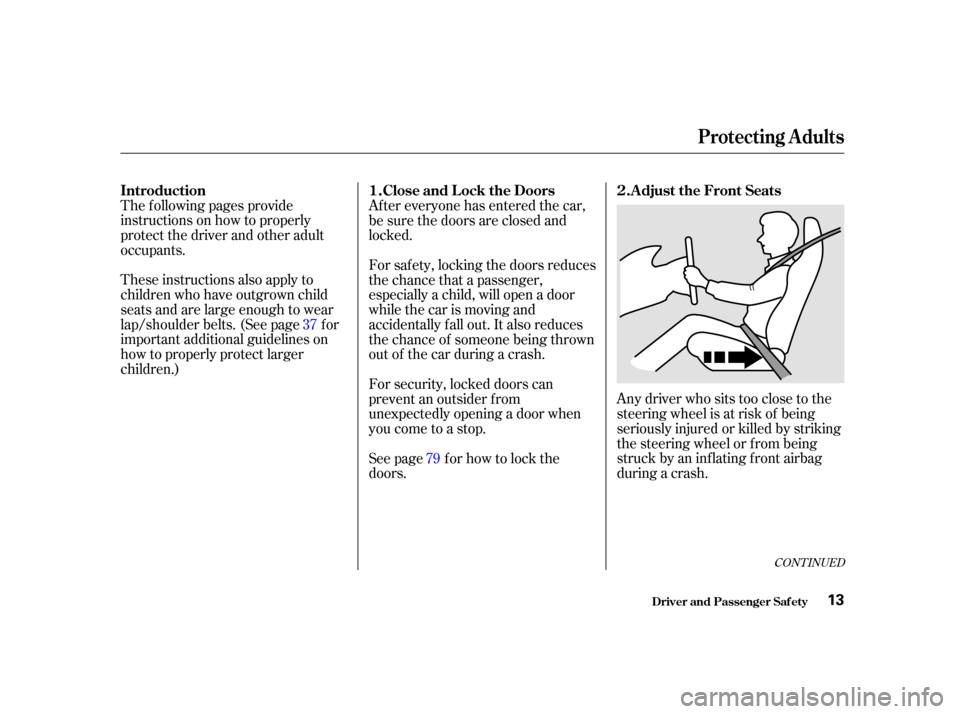
The f ollowing pages provide
instructions on how to properly
protect the driver and other adult
occupants.
These instructions also apply to
children who have outgrown child
seats and are large enough to wear
lap/shoulder belts. (See page f or
important additional guidelines on
how to properly protect larger
children.)Any driver who sits too close to the
steering wheel is at risk of being
seriously injured or killed by striking
the steering wheel or f rom being
struck by an inflating front airbag
during a crash.
Af ter everyone has entered the car,
be sure the doors are closed and
locked.
For saf ety, locking the doors reduces
the chance that a passenger,
especially a child, will open a door
while the car is moving and
accidentally f all out. It also reduces
the chance of someone being thrown
out of the car during a crash.
For security, locked doors can
prevent an outsider f rom
unexpectedly opening a door when
you come to a stop.
See page f or how to lock the
doors.
37
79
CONT INUED
Introduction A djust the Front Seats
Close and L ock the Doors
1. 2.
Protecting Adults
Driver and Passenger Saf ety13
Page 17 of 320

To reduce the chance of injury, wear
your seat belt properly, sit upright
with your back against the seat and
movetheseatawayfromthe
steering wheel to the f arthest
distance that allows you to maintain
f ull control of the car.
The National Highway Traffic Safety
Administration and Transport
Canada recommend that drivers
adjust the seat so the center of the
chest is at least 10 inches away f rom
the center of the steering wheel.
Also make sure your f ront seat
passenger moves the seat as f ar to
the rear as possible.Adjust the driver’s seat-back to a
comf ortable, upright position,
leaving ample space between your
chest and the airbag cover in the
center of the steering wheel. If you
sit too close to the steering wheel,
you could be injured if the f ront
airbag inflates.
Most shorter drivers can get f ar
enough away f rom the steering
wheel and still reach the pedals.
However, if you are concerned about
sitting too close, we recommend that
you investigate whether some type
of adaptive equipment may help.
Once your seat is adjusted correctly,
rock it back and f orth to make sure
the seat is locked in position.
See page f or how to adjust the
f ront seats. 86
Protecting Adults
Driver and Passenger Saf ety
Adjust the Seat-Backs
3.
14
Sitting too close to a front
airbag can result in serious
injury or death if the front
airbags inflate.
Always sit as far back from the
front airbags as possible.
Page 18 of 320
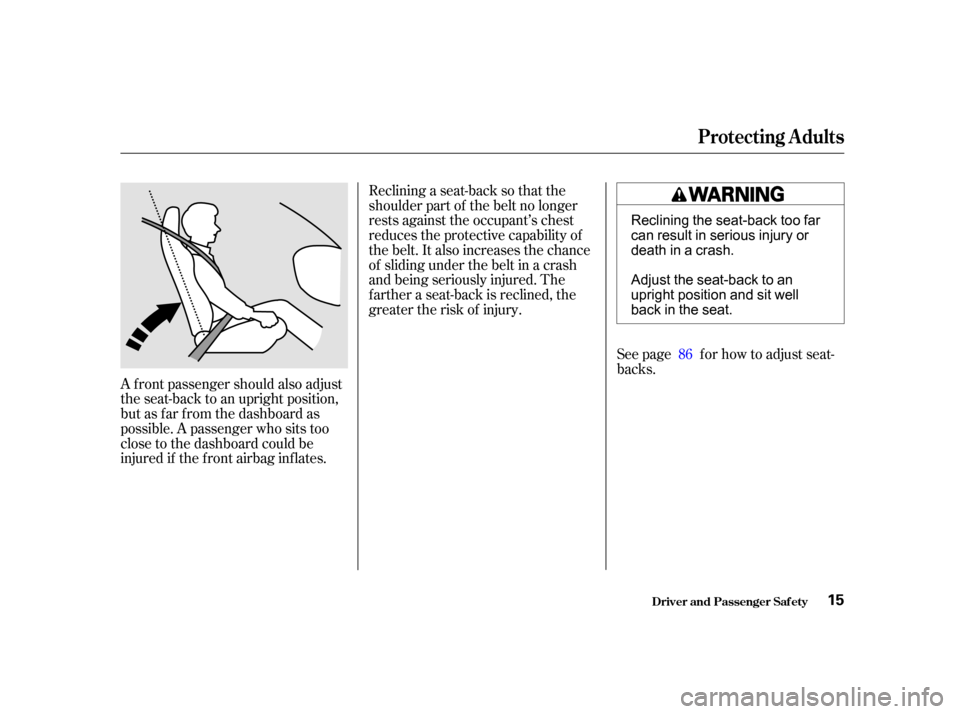
See page f or how to adjust seat-
backs.
Reclining a seat-back so that the
shoulder part of the belt no longer
rests against the occupant’s chest
reduces the protective capability of
the belt. It also increases the chance
of sliding under the belt in a crash
and being seriously injured. The
farther a seat-back is reclined, the
greater the risk of injury.
A f ront passenger should also adjust
the seat-back to an upright position,
but as f ar f rom the dashboard as
possible. A passenger who sits too
close to the dashboard could be
injured if the f ront airbag inf lates. 86
Protecting Adults
Driver and Passenger Saf ety15
Reclining the seat-back too far
can result in serious injury or
death in a crash.
Adjust the seat-back to an
upright position and sit well
back in the seat.
Page 20 of 320
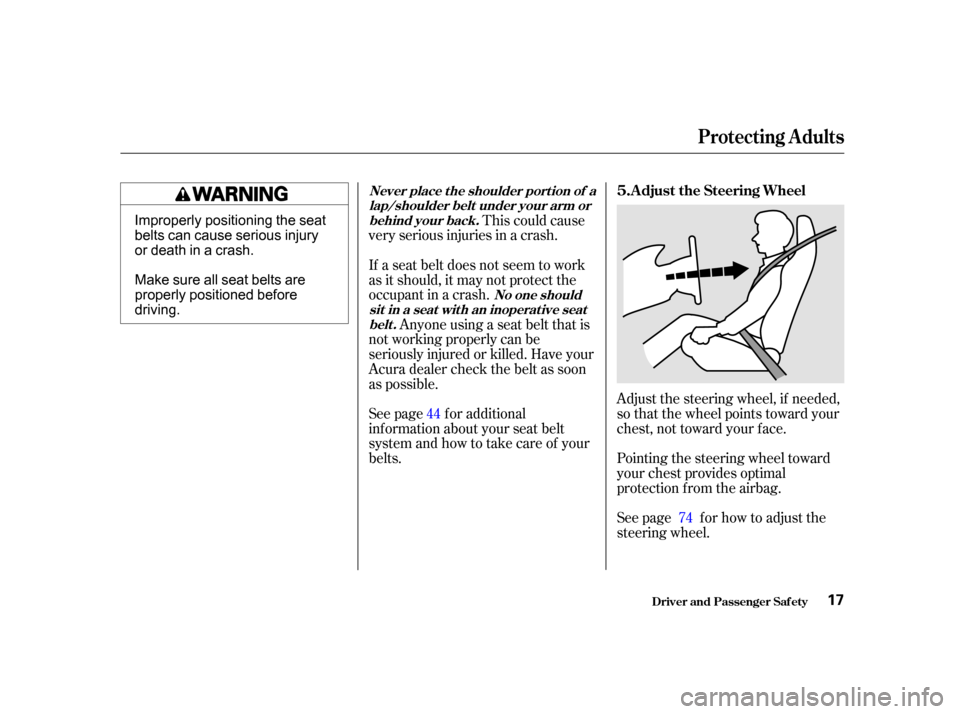
Adjust the steering wheel, if needed,
so that the wheel points toward your
chest, not toward your f ace.
Pointing the steering wheel toward
your chest provides optimal
protection f rom the airbag.
See page f or how to adjust the
steering wheel.
See page f or additional
inf ormation about your seat belt
system and how to take care of your
belts. This could cause
very serious injuries in a crash.
If a seat belt does not seem to work
as it should, it may not protect the
occupant in a crash.
Anyone using a seat belt that is
not working properly can be
seriously injured or killed. Have your
Acura dealer check the belt as soon
as possible.
44
74
A djust the Steering Wheel
5.
Protecting Adults
Driver and Passenger Saf ety
Never place t he shoulder port ion of a
lap/shoulder belt under your arm orbehind your back.
No one should
sit in a seat wit h an inoperat ive seat belt.
17
Improperly positioning the seat
belts can cause serious injury
or death in a crash.
Make sure all seat belts are
properly positioned before
driving.
Page 24 of 320
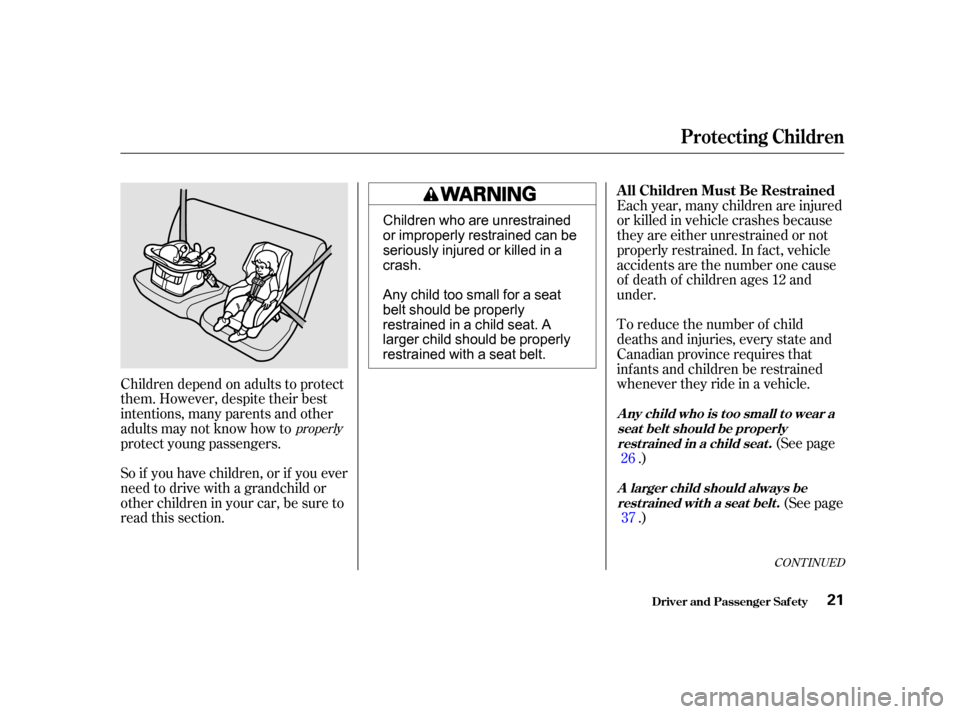
(See page
.)
To reduce the number of child
deaths and injuries, every state and
Canadian province requires that
inf ants and children be restrained
whenever they ride in a vehicle. Each year, many children are injured
or killed in vehicle crashes because
they are either unrestrained or not
properly restrained. In f act, vehicle
accidents are the number one cause
of death of children ages 12 and
under.
Children depend on adults to protect
them. However, despite their best
intentions, many parents and other
adults may not know how to
protect young passengers.
So if you have children, or if you ever
need to drive with a grandchild or
otherchildreninyourcar,besureto
read this section. (See page
.)
26
37
properly
CONT INUED
Driver and Passenger Saf ety
Protecting Children
All Children Must Be Restrained
Anychildwhoistoosmalltoweara seat belt should be properlyrest rained in a child seat .
A larger child should always berest rained wit h a seat belt .
21
Children who are unrestrained
or improperly restrained can be
seriously injured or killed in a
crash.
Any child too small for a seat
belt should be properly
restrained in a child seat. A
larger child should be properly
restrained with a seat belt.
Page 26 of 320
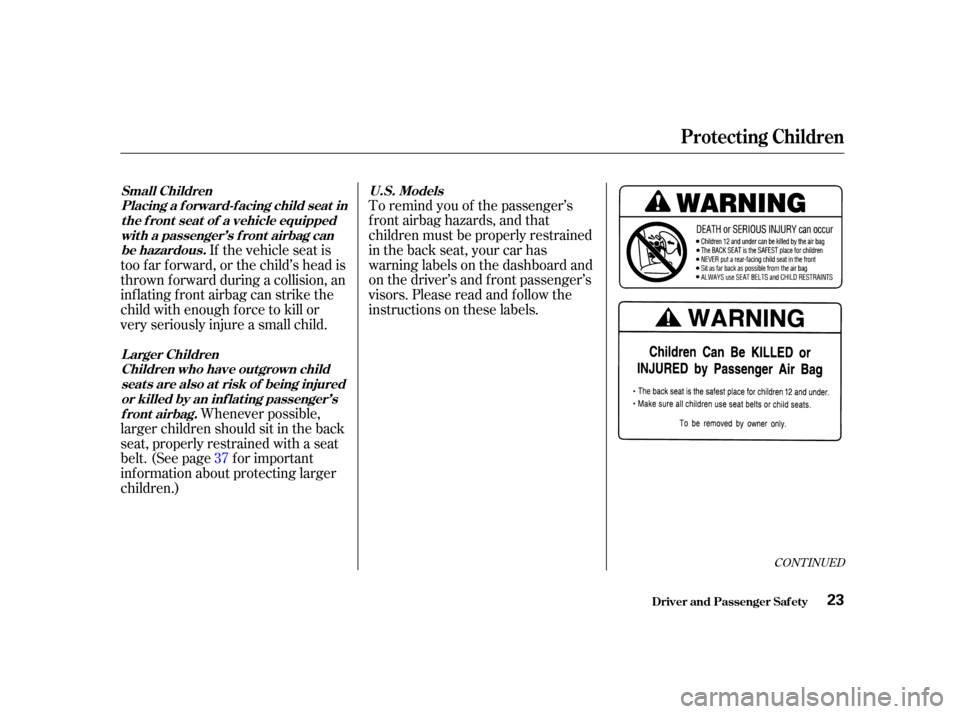
CONT INUED
To remind you of the passenger’s
f ront airbag hazards, and that
children must be properly restrained
in the back seat, your car has
warninglabelsonthedashboardand
on the driver’s and f ront passenger’s
visors. Please read and f ollow the
instructions on these labels.
Whenever possible,
larger children should sit in the back
seat, properly restrained with a seat
belt. (See page f or important
inf ormation about protecting larger
children.) If the vehicle seat is
too far forward, or the child’s head is
thrown f orward during a collision, an
inflating front airbag can strike the
child with enough f orce to kill or
very seriously injure a small child.
37
Driver and Passenger Saf ety
Protecting Children
U.S. Models
Small Children
Children who have outgrown childseat s are also at risk of being injuredor killed by an inf lat ing passenger’sfront airbag.
Placing a f orward-f acing child seat in
t he f ront seat of a vehicle equippedwit h a passenger’s f ront airbag canbe hazardous.
Larger Children
23
Page 27 of 320
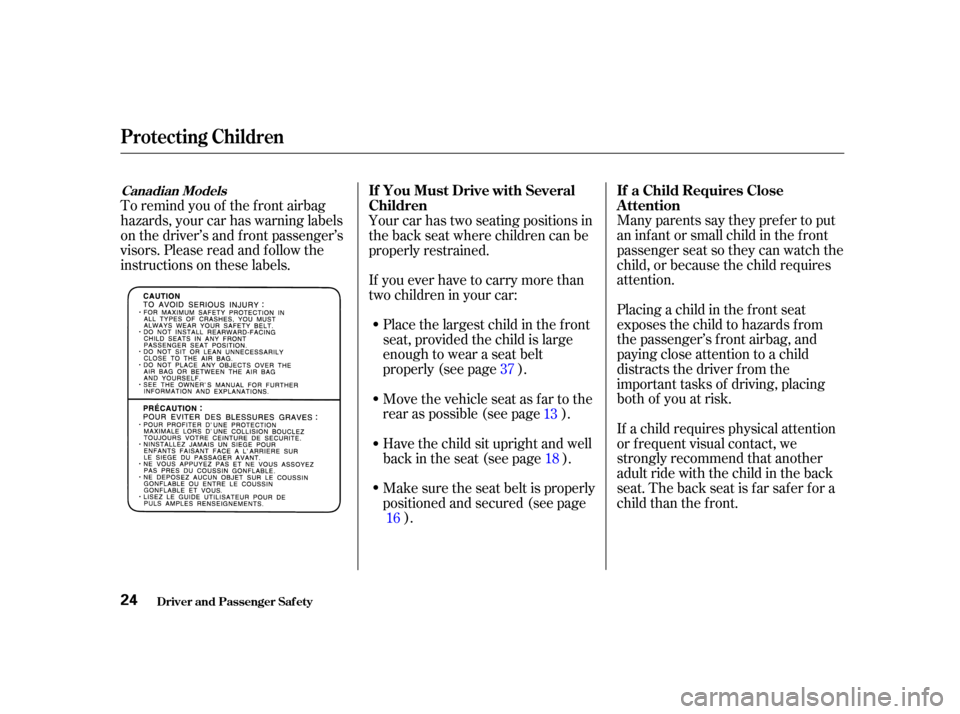
Many parents say they pref er to put
an infant or small child in the front
passenger seat so they can watch the
child, or because the child requires
attention.
Placing a child in the f ront seat
exposes the child to hazards f rom
the passenger’s f ront airbag, and
paying close attention to a child
distracts the driver f rom the
important tasks of driving, placing
both of you at risk.
If a child requires physical attention
or f requent visual contact, we
strongly recommend that another
adult ride with the child in the back
seat. The back seat is far safer for a
child than the front.
Place the largest child in the f ront
seat, provided the child is large
enough to wear a seat belt
properly (see page ).
Move the vehicle seat as far to the
rear as possible (see page ).
Have the child sit upright and well
backintheseat(seepage ).
Make sure the seat belt is properly
positioned and secured (see page
).
To remind you of the f ront airbag
hazards, your car has warning labels
on the driver’s and f ront passenger’s
visors. Please read and f ollow the
instructions on these labels.
Your car has two seating positions in
the back seat where children can be
properly restrained.
If you ever have to carry more than
twochildreninyourcar:
371318
16
Driver and Passenger Saf ety
Protecting Children
If a Child Requires Close
Attention
If You Must Drive with Several
ChildrenCanadian Models
24
Page 29 of 320
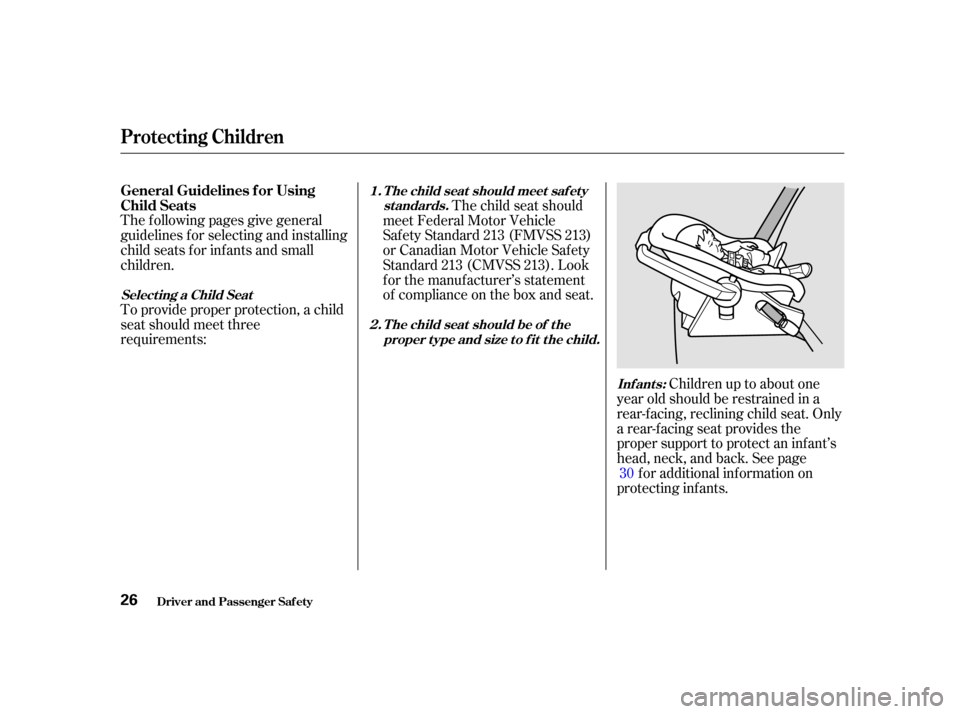
The f ollowing pages give general
guidelines f or selecting and installing
child seats f or inf ants and small
children.Childrenuptoaboutone
year old should be restrained in a
rear-facing, reclining child seat. Only
a rear-f acing seat provides the
proper support to protect an inf ant’s
head, neck, and back. See page for additional information on
protecting inf ants.
To provide proper protection, a child
seat should meet three
requirements:
The child seat should
meet Federal Motor Vehicle
Saf ety Standard 213 (FMVSS 213)
or Canadian Motor Vehicle Saf ety
Standard 213 (CMVSS 213). Look
for the manufacturer’s statement
of compliance on the box and seat.
30
General Guidelines f or Using
Child Seats
Inf ant s:
Select ing a Child Seat T he child seat should meet saf et y
st andards.
T he child seat should be of theproper t ype and size t o f it t he child.
2.
1.
Protecting Children
Driver and Passenger Saf ety26